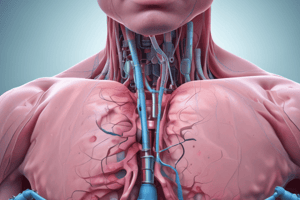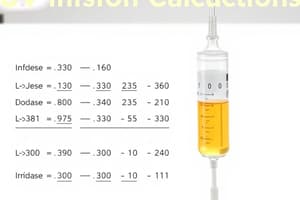Podcast
Questions and Answers
Welche Methode wird verwendet, um Einzeller im Heuaufguss zu beobachten?
Welche Methode wird verwendet, um Einzeller im Heuaufguss zu beobachten?
- Heu in einem Mixer zerkleinern und sofort untersuchen.
- Heu unter direkter Sonneneinstrahlung trocknen.
- Eine Probe von Wasser aus einem Teich mit Heu vermischen und einige Tage ruhen lassen. (correct)
- Das Heu in einem Wasserkocher kochen.
Welche der folgenden Einzeller ändert ihre Form?
Welche der folgenden Einzeller ändert ihre Form?
- Amöbe (correct)
- Waffentierchen
- Glockentierchen
- Pantoffeltierchen
Was ist das Hauptnahrungsmittel für die Mikroorganismen im Heuaufguss?
Was ist das Hauptnahrungsmittel für die Mikroorganismen im Heuaufguss?
- Heu (correct)
- Luft
- Bakterien
- Wasser
Was beschreibt die Kahmhaut im Heuaufguss?
Was beschreibt die Kahmhaut im Heuaufguss?
Welche der folgenden Funktionen führen Einzeller nicht aus?
Welche der folgenden Funktionen führen Einzeller nicht aus?
Flashcards
Heuaufguss
Heuaufguss
Eine Methode, um Einzeller im Wasser zu züchten.
Pantoffeltierchen
Pantoffeltierchen
Ein Einzeller mit charakteristischer Form und Bewegung durch Cilien.
Amöbe
Amöbe
Ein Einzeller, der seine Form verändert.
Kahmhaut
Kahmhaut
Signup and view all the flashcards
Einzeller
Einzeller
Signup and view all the flashcards
Study Notes
Einzeller im Heuaufguss
- Zellkultur: A method to cultivate microscopic organisms, specifically using hay infusion
- Material: A glass jar, hay, and water from a puddle or rain barrel create a suitable environment to grow microscopic organisms
- Observation: A microscope is necessary to view the variety of microscopic organisms in significant numbers
- Hay Infusion: The hay is submerged in water, and the suspension is left in a warm place to facilitate growth
Hay Infusion Technique
- Setup: A glass jar with 2-3 grams of hay is filled. The hay is covered, leaving space between the hay and the top.
- Conditions: To allow for the growth of organisms, the jar needs to be kept warm. A lid is not needed because the organisms need oxygen to thrive.
- Growth: A film, called the Kahmhaut (a white film), develops on the surface of the water.
- Organisms: The organisms in the hay infusion feed on the hay and contribute to the growth of other organisms in and on the hay.
Observation and Identification
- Microscope Use: A microscope is indispensable for a detailed examination and identification of the organisms.
- Collecting Sample: Use a pipette to obtain a sample from beneath the Kahmhaut to analyze with a microscope.
- Observation Focus: Examine the organisms, their structure, motility, feeding strategies, etc.
- Comparison: Compare the observed organisms with existing classifications of organisms.
Specific Organisms (with examples)
- Pantoffeltierchen: A specific organism and its movement, as well as the effect of gelatin.
- Amöbe: A microscopic single-celled organism.
- Glockentierchen: A microscopic single-celled organism.
- Waffentierchen: A microscopic single-celled organism.
Studying That Suits You
Use AI to generate personalized quizzes and flashcards to suit your learning preferences.




